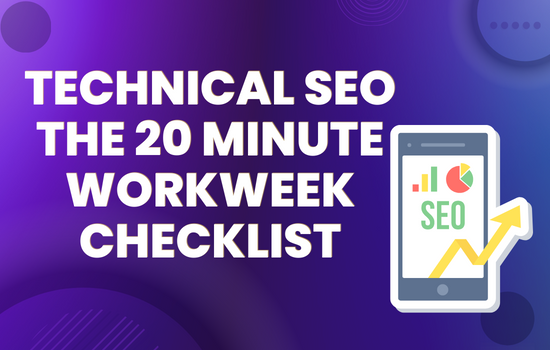Although just a small percentage of us employ tech SEO checklist to its full potential, it affects everyone. If we were to examine SEO in detail, which aspect would not be considered technical?
Today’s tech SEO checklist covers all SEO problems, blunders, advice, and tips. In order to make your website user-friendly, effective, noticeable in SERP, functional, and simple to comprehend, we tried to cover every aspect in the most efficient way we could, so gather all the data you have on your website, and let’s improve with this SEO technical checklist guide.
The Complete technical SEO checklist:
- Improve your page experience – essential web vitals:
Core Web Vitals and current search signals are combined in Google’s new page experience signals as an illustration :
Guidelines for mobile friendliness, secure HTTPS browsing, and invasive pop-ups.
If you need a refresher, the three components that makeup Google’s Core Web Vitals are as follows:
- First Input Delay (FID) – The FID calculates the time it takes before a user may interact with a website. The page should have an FID of under 100 ms to guarantee a positive user experience.
- We measure the largest contentful element on the screen using the Largest Contentful Paint (LCP) metric moreover, to give the customer a positive experience, this should take place in less than 2.5 seconds.
- Cumulative Layout Shift (CLS) is a metric used to gauge the visual stability of screen elements therefore Sites should make an effort to keep their pages’ CLS values under.1 second.
These ranking criteria are quantified in a report available in Google Search Console, which displays which URLs might have problems.
There are many tools available to help you increase Core Web Vitals and the speed of your website and, Google PageSpeed Insights is the most important.
You may measure the speed of various pages on your website with Webpagetest.org from multiple locations, operating systems, and devices.
You may optimize your website to make it load faster by doing the following:
- Putting lazy-loading into practice for non-critical photos.
- Enhancing the browser’s image formats to improve JavaScript performance.
- Check your website for crawl issues by crawling it.
Second, make sure there are no crawl issues on your website. When a search engine tries to access a page on your website but is unsuccessful, it encounters a crawl error.
There are numerous tools available that can assist you with this, like Screaming Frog and other web crawling software. Search for any crawl issues after you’ve crawled the website. Additionally, you can use Google Search Console to verify this.
You should scan for crawl faults when looking for them.
- a) Use 301 redirects to correctly implement all redirects.
- b) Examine any 4xx and 5xx problem pages to determine the destination you wish to reroute them to.
- Correct faulty inbound and outbound links.
Both humans and search engines might have a negative user experience as a result of bad link structure. It can be upsetting for visitors to your website to click a link and discover that it doesn’t take them to the right or functional URL.
You should make careful to look out for the following variables:
- Links that redirect to another website with a 301 or 302 code.
- That led to a 4XX error page.
- An excessively deep internal connecting structure.
Update the target URL or, if the link no longer exists, remove it entirely to fix broken links.
- Remove any redundant or inadequate text.
Make sure your website doesn’t include any duplicate or weak material. Many things, such as page replication from faceted navigation, having multiple live versions of the site, and scraped or cloned information, might result in duplicate content.
You should only permit Google to index one version of your website. For instance, instead of recognizing these domains as a single website, search engines treat them all as separate websites:
- Visit ABC at https://www.abc.com.
- https://www.abc.com
- Visit ABC at http://www.abc.com.
- https://www.abc.com
- Switch to the HTTPS protocol on your website
Google first declared that the HTTPS protocol was a ranking component in 2014. Therefore, if your website is still using HTTP in 2022, it’s time to make the change.
- Ensure that the URLs you use have a clear structure.
The URL structure of a site should be as basic as feasible, according to Google.
Because they generate an excessively high number of URLs that refer to the same or comparable information on your site, excessively complicated URLs are problematic for spiders.
Because of this, Googlebot might not be able to fully index all of the material on your website.
Problematic URL samples are provided below:
Parameters for sorting. There are many different ways to sort the same things on certain huge shopping sites, which leads to a substantially higher number of URLs.
You should try to shorten URLs whenever you can by eliminating these extra parameters.
- Ascertain that your website has an optimized XML sitemap.
Search engines know about your site’s structure and what to index in the SERP through XML sitemaps.
An ideal XML sitemap should have the following:
- Any updated material on your website (recent blog posts, products, etc.).
- 200-status URLs
- A maximum of 50,000 URLs. To maximize your crawl budget, you should have numerous XML sitemaps if your site has more URLs.
The following should be removed from the XML sitemap:
- URLs with parameters
- The URLs with canonical or no-index tags, or those that are 301 redirecting
- URLs with the status codes 4xx or 5xx
- duplicated materials
If your XML sitemap has any index issues, you can check the Index Coverage report.
- Ensure to optimize the robots.txt file on your website.
The robots that crawl your website are given instructions in robots.txt files.
It’s crucial to make sure that only your most crucial sites are being indexed because every website has a “crawl budget,” or a finite number of pages that can be included in a crawl.
On the other hand, you must ensure that nothing you certainly want to be indexed is being blocked by your robots.txt file.
You should block the following URLs in your robots.txt file as examples:
- Temporary records
- Admin pages
- Checkout and cart pages
- Pages connected to searches
- Websites with parameters
The XML sitemap’s location should come in the robots.txt file, as a final step. Utilize Google for verification.
- Add schema markup or structured data
Structured data assists in giving Google context about a page’s significance and makes your organic listings stand out in the SERPs by providing information about the page and its content.
Schema markup is one of the most popular forms of structured data.
Schema markups come in a variety of forms and structure data for a wide range of topics, including individuals, places, organizations, small companies, reviews, and much more.
Online schema markup generators are available for instance from Merkle.
The creation of schema markup for your website can also be aided by Google’s Structured Data Testing Tool.
- Tech SEO checklist by Toolsbox
Variations in the tech SEO checklist site health can result from even minor website adjustments furthermore If the anchor text on your internal website or the website you are connecting to changes, internal and external links will no longer function. Schema markup, sitemaps, and robots.txt are crucial SEO components that are not always transferred over or moved to a location that Google will not recognize. To ensure that a technical SEO issue is not interfering with organic website traffic, develop a strategy to perform a crawl of your site and examine each item on the SEO technical checklist so we have significant changes. You should also do this on a frequent basis.







